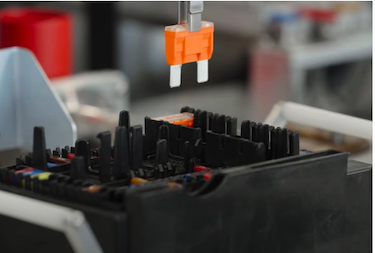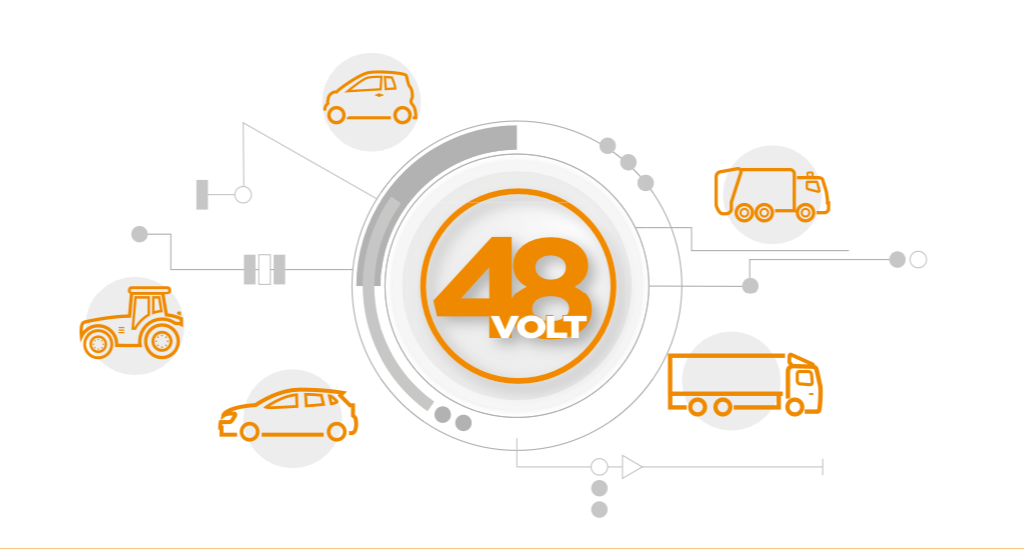48-Volt Systems and Connectors: QA with an Expert
Connector manufacturers have responded to the challenge and designed connectors specifically for 48V systems. TE Connectivity is one such company. Wiring Harness News recently spoke with Boris Ketscher, Product Manager at TE Connectivity to ask him more about the attributes of 48V systems, and some of the features that went into designing their 48V connector line.
WHN: We read a great deal about what the 48V systems will power, but what specific advantages do they bring to the table?
Boris: There are a few reasons for having a 48V layer in the architecture next to the 12V network. It depends on where you want to apply 12V or 48V to determine what is the better solution for the increased power demand, and the required CO2 emission reduction. Both challenges need to push mechanical aggregates, such as cooling fans and compressors, towards electrical driven aggregates to 48V.
First, with a classic 12V system, the increase of power would demand a larger current, and thus a larger cable cross section (because power is a linear function of voltage and current). This would also add cost and weight to the harness. The 48V system needs only 25% of the current with a smaller cross section of the cable for the same application.
Second, we have less expensive and more powerful electronics in the car. It becomes increasingly simple to create different voltage levels with converters.
Another advantage of having 48V over high voltage batteries of 400V and more, is that with a moderate power consumption for hybrids, the re-use of existing 12V connectors and cables is possible to a certain extent.
For maintenance and safety regulations of the car, there are electrical safety advantages with a 48V system compared to high voltage system.
WHN: It seems like 12V systems will run in tandem with 48V, least for a while, but do you see 12V being eliminated eventually?
Boris: If we look at the cockpit and infotainment applications in the car, it is common that the 12V network reduces to 5V, 3V and below for data connectivity and microcontrollers inside the black boxes. It is more efficient to step down from a 12V towards a 5V voltage application than having to convert from 48V or higher directly into 3V or 5V (e.g. thermal losses). It is also more cost effective to have zones with 12V which only require 1 reduction from 48V to 12V. Once you are no longer in the high-power applications, but in the signal applications in the cabin, the wire size is more linked to robustness of the harness. Increasing voltage to 48V in signal applications does not lead any longer to reduction in wire size or weight saving. With our NanoMQS and PicoMQS terminals and connectors, we are close to the physical limits of known processes for crimping and handling the wires & connectors.
WHN: Back in the early 2000’s there was talk of 42V systems, but that seemed to go away. What’s different now to make these higher voltage systems more viable?
Boris: Mainly the CO2 reduction trend and legislation on emissions created the disruption in the industry to think different and step away from the combustion engine as single solution for the powertrain in a car.
Power can be saved if you don’t need to continuously drive the aggregates that consume a lot of energy from your combustion engine. Saving power means saving fuel, and this goes directly in CO2 emission reduction.
As the E-motors in hybrids become more powerful and the electronics more efficient to drive these engines, the batteries don’t need to be the size as in a full electrical car. The power density of batteries is also increasing rapidly which helps to reduce battery size. 48V is the ideal solution in between an internal combustion engine and a full electric solution. The 42V was the base for the set of new specifications that have been introduced for the 48V layer.
WHN: What were the challenges in developing 48V connectors automotive?
Boris: When 48V is used in miniaturization applications, the creep distance (shortest path over the insulation material between 2 conductors) and clearance must be sufficient to prevent short circuit.
And although the touch protection is not required as with high voltage connections (above 60V), the hot unplugging of power connections at 48V is a challenge and must be prevented by locking mechanisms or a HVIL (high voltage interlock function) similar as with high voltage applications.
It is possible to think you need a completely new portfolio of terminals and connectors. This would create a higher market entry price and make the supply chain for our harness maker customers much more complex (inventory increase, higher number of parts for 12V and 48V). But TE Connectivity looks at a more holistic approach where we want to deliver the same products for 48V as for 12V to our customers. Therefor we carefully selected and tested many of our current products and are labeling them as ‘48V ready’. Our waterproof connectors are designed in such way that they fulfill the requirements.
Our customers can pick any of these products suitable for 48V and process them in the same way they for 12V harnesses, again, addressing the above supply challenges.
For miniaturized applications, we designed new products with a higher pitch between the wires to overcome the creep distance, while keeping the packaging as small as possible to fit applications such as cell connections in batteries etc.
WHN: What are the typical wire sizes for 48V systems? Different insulation?
Boris: As mentioned, the power in the aggregates increases, and the wire size decreases because of the higher voltage level. This means the wire sizes to be used for 48V are in the same range as for 12V.
The re-use of existing 12V products at our customers fits in the end-to-end philosophy of TE, making sure that we keep the supply chain as lean as possible, providing the best solution to our customers.
WHN: Are the terminals all new for 48 V connectors or will they be different formats requiring different applicators?
Boris: TE has a complete portfolio of terminals and connectors. Terminals are not linked to a voltage level, only to a current carrying capacity and a limitation on wire size based on the crimp of welding flag (if cables are welded instead of crimped to the terminal).
It is possible to use the same terminal for 12V, 48V, 400V and beyond as long as the cable and connector housing provide the correct insulation protection and meet the required safety specifications.
Our terminals start at miniaturized solutions for blade sizes of 0.5mm for wires starting from 0.13mm or even 0.08mm² in specific cases, and extend to high power solutions such as our PCON21, with a 21mm blade size
WHN: What will be the different or new for manufacturers as they create the harnesses for these systems?
In the coming years, we still see an increase in contact points for the harnesses. There are more electric and electronic controlled functions in a car, and this will require more focus on weight saving on the harness, especially if costs for raw material (copper) would go up. Weight of the harness has a direct impact on C02 emission and is vulnerable to copper price swings.
This is leading to rethinking the harness and, on a higher level, the number of decentralized electronic controllers. A zonal architecture is the most suitable think path to deal with these challenges, and it doesn’t need to be a disruptive change. The move from a classic 12V harness, over 48V towards more zonal defined harnesses can be gradual, enabling the complete industry to adapt.
WHN: Do you see aftermarket equipment being designed to operate in the 48V environment? What factors would affect that?
Boris: TE is supportive to all of our customers. If companies design specific equipment for aftermarket that work on 48V, our platform 48V portfolio is available to support this.
We have a dedicated sales team covering smaller and emerging customers that can count on our experience and know-how to enable their product designs.































































